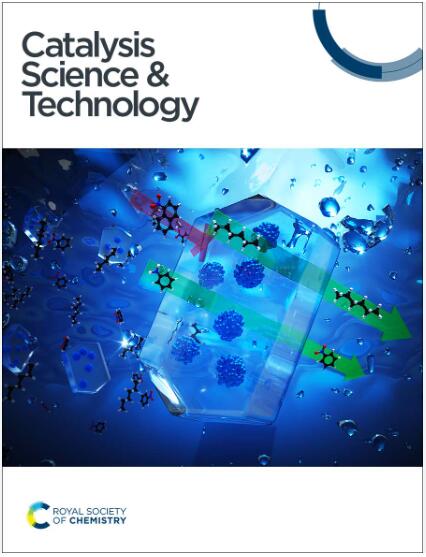Tuning ethanol synthesis pathways from syngas: nanosheet-structured K-doped Co–MoS2 catalysts and the role of CVD sulfidation†
IF 4.2
3区 化学
Q2 CHEMISTRY, PHYSICAL
引用次数: 0
Abstract
This study investigates the effect of activation methods (H2S sulfidation vs. chemical vapor deposition, CVD) on the catalytic performance of K-doped (Co)–MoS2 nanosheets supported on activated carbon (AJ-3) prepared from different Co-precursors (cobalt acetate vs. cobalt nitrate) for selective and non-selective ethanol synthesis from syngas. Advanced characterization techniques, including nitrogen sorption, XRF, SEM, SEM-EDX, STEM-EDX, STEM-HAADF, TEM, HRTEM, and XPS, were utilized to analyze the structural, compositional, and morphological properties of the synthesized catalysts. Notably, the K–(Co)MoS2/AJ-3 catalyst derived from cobalt nitrate via the CVD method exhibited exceptional ethanol selectivity, reaching 82%, significantly outperforming other alcohol products. In contrast, catalysts synthesized from cobalt acetate using the same CVD technique showed reduced activity for higher alcohol synthesis (HAS), favoring hydrocarbon formation and hydrogen spillover. Interestingly, the H2S sulfidation method applied to inorganic precursors resulted in unexpected methanol selectivity. This work highlights the critical role of precursor type and preparation methodology in tailoring catalytic performance, providing a comprehensive understanding of how these factors influence product selectivity and efficiency.

合成气乙醇合成途径的调整:纳米片结构k掺杂Co-MoS2催化剂和CVD硫化的作用
本研究考察了活化方法(H2S硫化vs化学气相沉积,CVD)对不同前驱体(醋酸钴vs硝酸钴)制备的k掺杂(Co) -MoS2纳米片在活性炭(j -3)上催化合成气选择性和非选择性乙醇合成性能的影响。利用氮吸附、XRF、SEM、SEM- edx、STEM-EDX、STEM-HAADF、TEM、HRTEM和XPS等先进表征技术对合成催化剂的结构、组成和形貌进行了分析。值得注意的是,CVD法制备的硝酸钴K - (Co)MoS2/AJ-3催化剂表现出优异的乙醇选择性,达到82%,明显优于其他醇类产品。相比之下,使用相同CVD技术由乙酸钴合成的催化剂对高醇合成(HAS)的活性降低,有利于碳氢化合物的形成和氢的溢出。有趣的是,应用于无机前体的H2S硫化方法产生了意想不到的甲醇选择性。这项工作强调了前驱体类型和制备方法在调整催化性能方面的关键作用,提供了对这些因素如何影响产物选择性和效率的全面理解。
本文章由计算机程序翻译,如有差异,请以英文原文为准。
求助全文
约1分钟内获得全文
求助全文
来源期刊

Catalysis Science & Technology
CHEMISTRY, PHYSICAL-
CiteScore
8.70
自引率
6.00%
发文量
587
审稿时长
1.5 months
期刊介绍:
A multidisciplinary journal focusing on cutting edge research across all fundamental science and technological aspects of catalysis.
Editor-in-chief: Bert Weckhuysen
Impact factor: 5.0
Time to first decision (peer reviewed only): 31 days
 求助内容:
求助内容: 应助结果提醒方式:
应助结果提醒方式:


